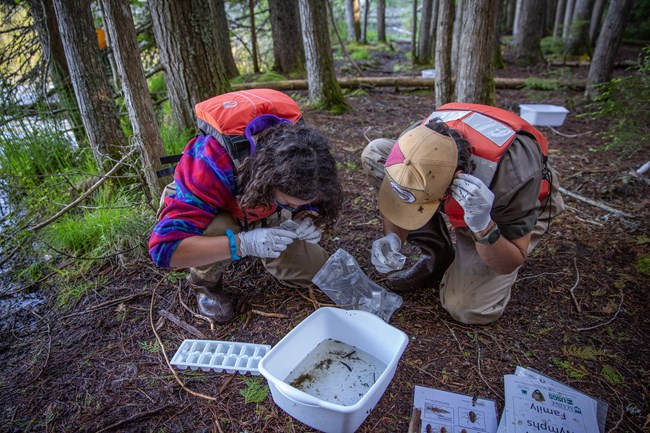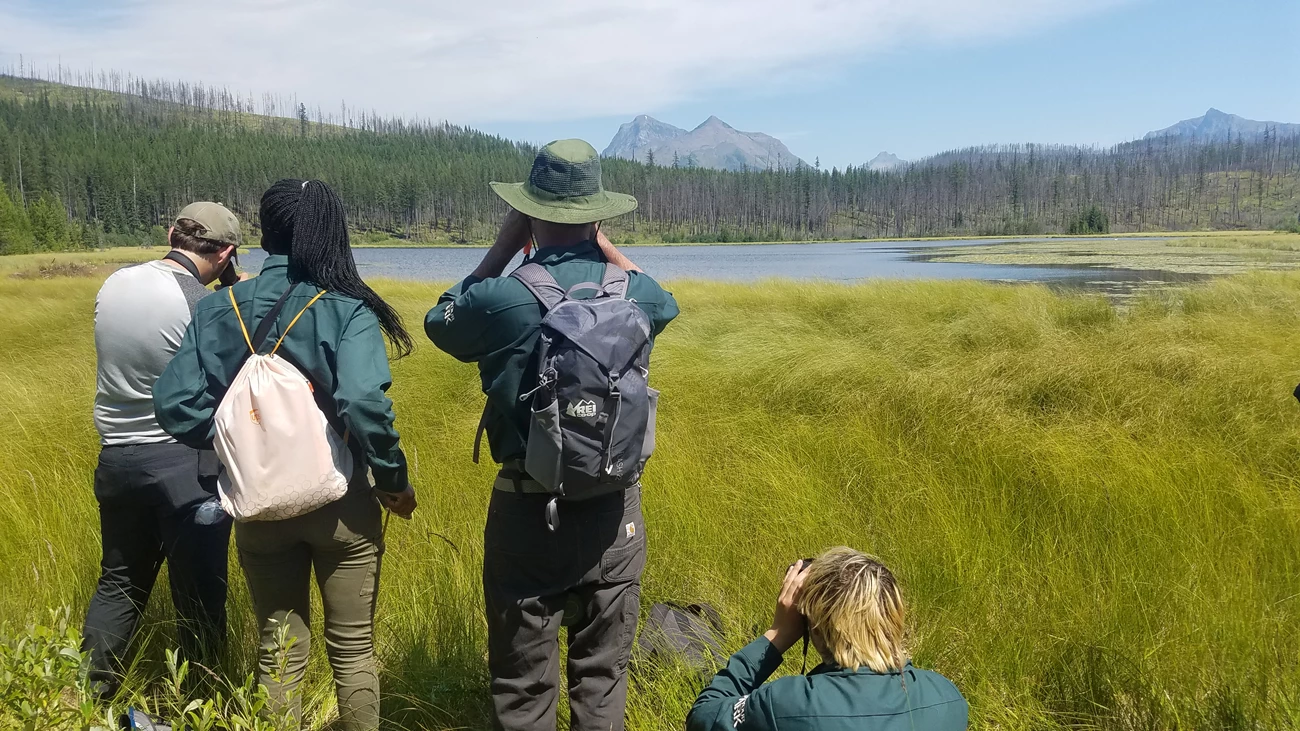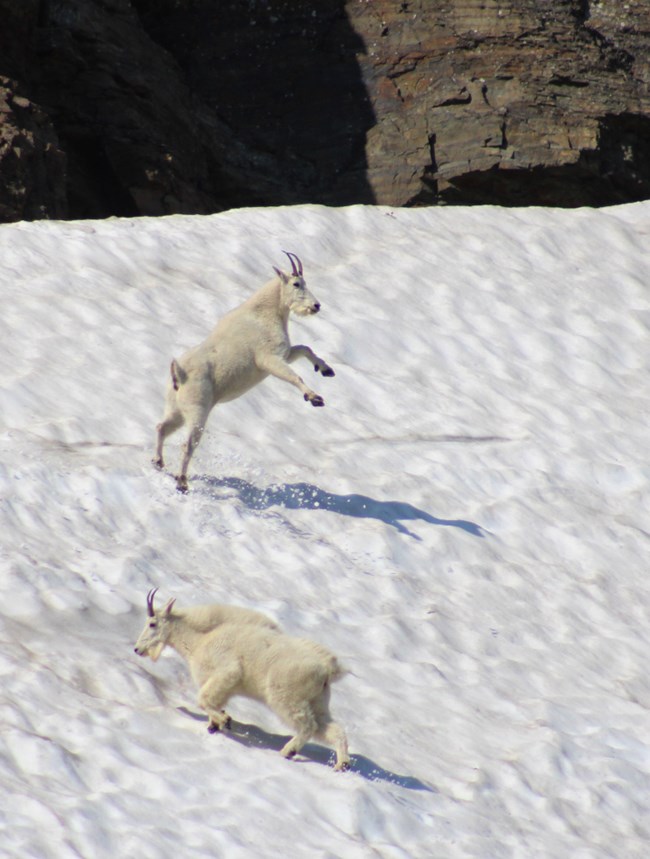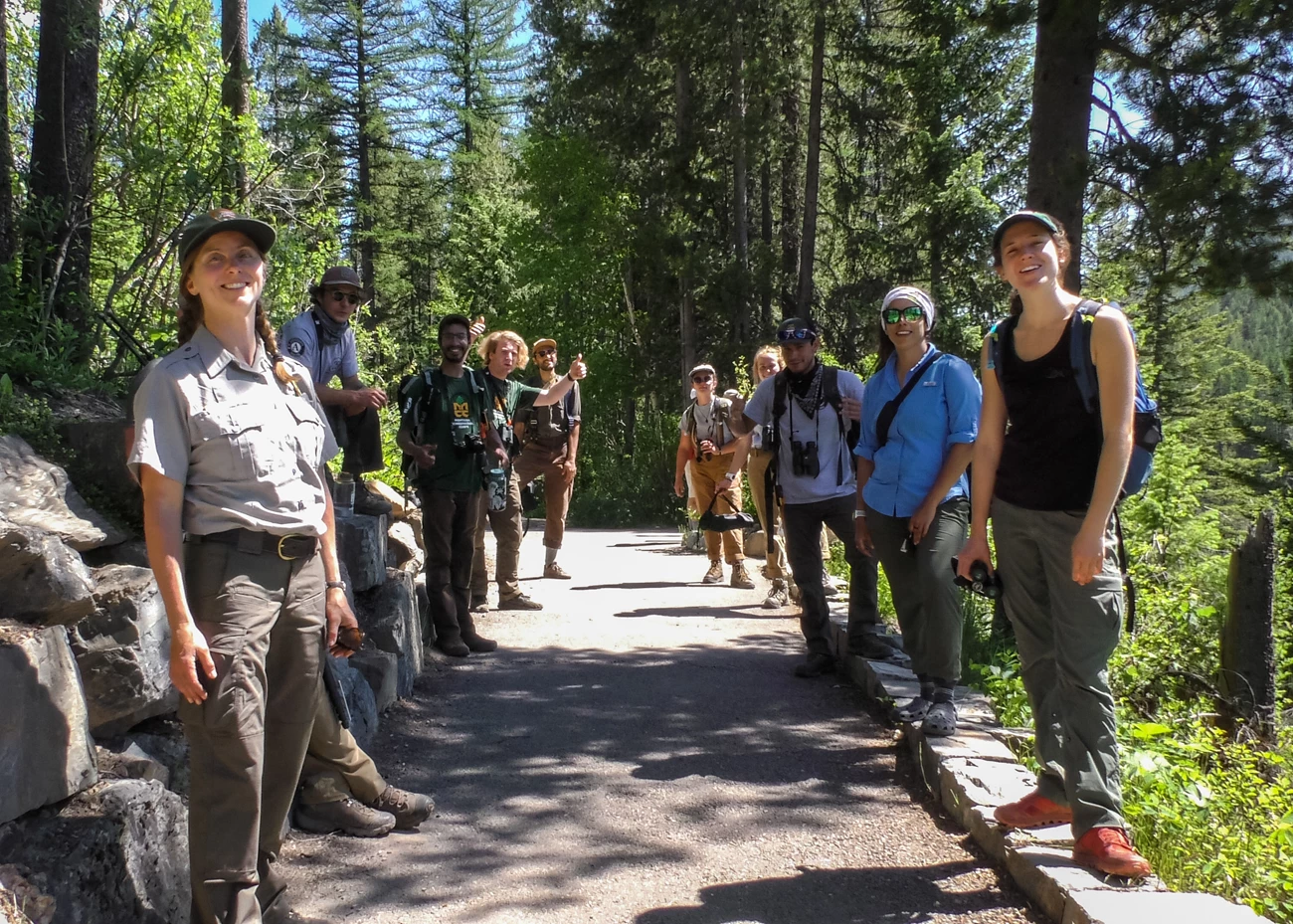Last updated: February 23, 2021
Article
Citizen Science Persists in the Face of COVID-19
By Anna Moser

NPS Photo/Jessi Mejia
In a summer season like no other, Citizen Science Program volunteers and staff faced the daunting task of gauging the population health of several charismatic indicator species, all while navigating new challenges presented by the Covid-19 pandemic.
While Glacier National Park was closed during the spring and early summer, the Research Learning Center kept citizen scientists active outside the park boundary by way of the Huckleberry Phenology project. Volunteers were provided a new training video and introduced to the Survey123 mobile data collection app. We also launched our refined Survey123 form for the Common Loon project, giving citizen scientists the opportunity to collect data on loons residing at lakes outside of Glacier.
Due to restrictions on volunteer involvement resulting from the pandemic, participation in 2020 summer fieldwork for the Citizen Science Program was limited to previously trained Volunteers in the Parks (VIPS), select outreach groups, and staff only. Citizen science staff held several small group, outdoor training sessions to refresh volunteers on data collection protocols, and introduce the Survey123 mobile data collection app. Additionally, park staff that do not typically perform fieldwork for their duties, such as interpretive rangers, were given training to help with this summer’s data collection. Volunteers then collected data at accessible sites across the open areas of the park, while park staff focused on covering east side areas, which were closed to the public during 2020 due to the Blackfeet Nation’s concerns regarding COVID-19.
The majority of our small volunteer force focused their attention on the Common Loon and High Country Citizen Science Projects, collecting population size and distribution data on Common Loons, mountain goats, and bighorn sheep within Glacier National Park. In addition to these seasoned volunteers, our program hosted two outreach groups–a Montana Conservation Corps crew and a group of Groundwork USA youth volunteers.
While Glacier National Park was closed during the spring and early summer, the Research Learning Center kept citizen scientists active outside the park boundary by way of the Huckleberry Phenology project. Volunteers were provided a new training video and introduced to the Survey123 mobile data collection app. We also launched our refined Survey123 form for the Common Loon project, giving citizen scientists the opportunity to collect data on loons residing at lakes outside of Glacier.
Due to restrictions on volunteer involvement resulting from the pandemic, participation in 2020 summer fieldwork for the Citizen Science Program was limited to previously trained Volunteers in the Parks (VIPS), select outreach groups, and staff only. Citizen science staff held several small group, outdoor training sessions to refresh volunteers on data collection protocols, and introduce the Survey123 mobile data collection app. Additionally, park staff that do not typically perform fieldwork for their duties, such as interpretive rangers, were given training to help with this summer’s data collection. Volunteers then collected data at accessible sites across the open areas of the park, while park staff focused on covering east side areas, which were closed to the public during 2020 due to the Blackfeet Nation’s concerns regarding COVID-19.
The majority of our small volunteer force focused their attention on the Common Loon and High Country Citizen Science Projects, collecting population size and distribution data on Common Loons, mountain goats, and bighorn sheep within Glacier National Park. In addition to these seasoned volunteers, our program hosted two outreach groups–a Montana Conservation Corps crew and a group of Groundwork USA youth volunteers.

NPS Photo/David Restivo
The crew also spent a day participating in the Dragonfly Mercury Project, a multi-park program that engages citizen scientists in the collection of juvenile dragonflies for mercury analysis. Fieldwork for this project was conducted at Johns Lake, where crewmembers strapped on waders and jumped in the muck to search for larvae. By stirring up the plant and sediment layers just below the surface of the water, participants were able to capture various aquatic invertebrates and identify dragonfly larvae. Once collected, samples were sent to the U.S. Geological Survey Contaminant Ecology Laboratory in Corvallis, Oregon for analysis. This research provides mercury levels to Glacier National Park and the surrounding ecosystems, providing valuable data for understanding the potential health risks of mercury contamination.
Our second volunteer outreach group, Groundwork USA, consisted of a crew of nine high school students and two leaders, with participants hailing from Dallas and Indianapolis. After completing a brief training, the group surveyed several lakes for Common Loons. All of the crew members observed and witnessed a loon call for the first time, and even watched a loon act territorially towards a hawk and an osprey at Winona Lake!

NPS Photo/Emma Hilliard
Given the obstacles presented this summer, Citizen Science Program volunteers and staff were able to accomplish a remarkable amount of fieldwork. Despite having only a fraction of the volunteer force we see in typical years, we were able to reach every single designated goat and loon field site in 2020, visiting many of those on multiple occasions.

NPS Photo/Jessi Mejia
This season’s Common Loon population produced nine chicks at six different lakes. Volunteers also saw loons on several unexpected lakes, such as Grinnell Lake, Lower Two Medicine Lake, and Lake Ellen Wilson. Nesting occurred on lakes where we have documentation of previous nesting success. After compiling nesting histories, we determined nesting has occurred at 17 lakes within the park, and six lakes outside the park since 2006.
In addition to our Common Loon surveys, staff deployed four remote cameras around known nesting sites, attempting to capture time-lapse photos of nest disturbances. The cameras were installed in the spring while the park was closed to the public–when the chance of human disturbance was minimal. While the camera batteries died prior to hatch dates at several lakes, the cameras captured evidence of both hawks and eagles perched on, or near, nests at two different lakes.
This summer, in addition to our recently developed survey app for the Common Loon Project, a new draft survey app was released for mountain goat and bighorn sheep surveys. Volunteers piloted the app in the field, helping us address questions and quirks. This feedback provides essential information and ensures the app functions as an effective and user-friendly data collection tool. Survey123 has also created the opportunity for us to more accurately pinpoint wildlife observations geographically, opening doors for new data analysis in the future.
This fall, as we moved into migration season and cooler autumn weather, trained VIP’s finished out the field season with the annual Hawkwatch Citizen Science Project. Volunteers made the first trek up to the Mount Brown Hawk Watch site on September 10 and counted a total of 1,450 migrating Golden Eagles by October 15, when snow piles of over two feet made surveys somewhat challenging! The highest single day count was on October 2 with 316 Golden Eagles!
At the Lake McDonald Lodge Hawk Watch site, dedicated observers, including many who have been counting eagles at this site for several decades, observed 412 golden eagles starting on September 22 to date. The highlight occurred on October 20–a day that the sun finally broke out after significant snow storms–when volunteers and staff documented 173 Golden Eagles making their way to warmer southern locations.
We extend our gratitude to the dedicated VIP’s and park staff that participated this summer, and greatly look forward to welcoming our full assemblage of citizen scientists back to the park next summer!
This fall, as we moved into migration season and cooler autumn weather, trained VIP’s finished out the field season with the annual Hawkwatch Citizen Science Project. Volunteers made the first trek up to the Mount Brown Hawk Watch site on September 10 and counted a total of 1,450 migrating Golden Eagles by October 15, when snow piles of over two feet made surveys somewhat challenging! The highest single day count was on October 2 with 316 Golden Eagles!
At the Lake McDonald Lodge Hawk Watch site, dedicated observers, including many who have been counting eagles at this site for several decades, observed 412 golden eagles starting on September 22 to date. The highlight occurred on October 20–a day that the sun finally broke out after significant snow storms–when volunteers and staff documented 173 Golden Eagles making their way to warmer southern locations.
We extend our gratitude to the dedicated VIP’s and park staff that participated this summer, and greatly look forward to welcoming our full assemblage of citizen scientists back to the park next summer!

NPS Photo/Renata Harrison
